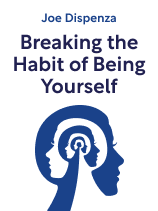

This article is an excerpt from the Shortform book guide to "Breaking the Habit of Being Yourself" by Joe Dispenza. Shortform has the world's best summaries and analyses of books you should be reading.
Like this article? Sign up for a free trial here.
What is Joe Dispenza’s Breaking the Habit of Being Yourself about? What is the key message to take away from the book?
Joe Dispenza suggests that it’s our habits that keep us from growing and creating the life we want. In Breaking the Habit of Being Yourself, he offers a detailed guide on how to get rid of those habits and replace them with habits that move us toward our ideal selves.
Below is a brief overview of Breaking the Habit of Being Yourself by Joe Dispenza.
Breaking the Habit of Being Yourself: How to Lose Your Mind and Create a New One
In Breaking the Habit of Being Yourself, Joe Dispenza explains that unhappiness is the result of bad habits that make up our personality. Personal growth requires unlearning those habits, creating a new you, and using meditation to manifest the life you want. He explains what makes us think and feel the way we do, how that affects the condition of our lives, and how to use this information to form a brand new, better version of ourselves.
Joe Dispenza has a Doctorate of Chiropractic degree and has done extensive postgraduate training in neuroscience, brain chemistry, and cellular biology, among other things. He is the author of Evolve Your Brain, as well as the New York Times bestseller, You Are the Placebo.
In our guide, we’ll look at the role of the brain and body in forming and maintaining our habits, as well as how to overcome these habits and break free from our old selves. We’ll explore Dispenza’s meditation technique. Finally, we’ll explore what the new “you” will look like once you’ve implemented and mastered his techniques. We’ll also look at the science behind Dispenza’s ideas and compare them to advice from other authors on how to change your habits and yourself.
Where Do Our Habits Come From?
As Dispenza explains, changing your life requires changing your habits. Your habits are thoughts, emotions, and behaviors that you engage in regularly.
According to Dispenza, habits (as well as traits and skills) develop through a set of predictable steps: first, through conscious thinking—learning the information needed for that habit. Then, through doing—experiencing it, processing it, and retaining it emotionally. Finally, through being—internalizing it as an unconscious behavior or feature of your self. Once you’ve mastered a habit, skill, or trait, it becomes ingrained in you and your external environment can’t easily interfere with it.
Sometimes, we develop bad habits. When bad habits begin to run your life, your health and well-being suffer. This is because the thoughts and emotions that make up a habit have a real and immediate impact on your body. According to Dispenza, when you remember or imagine something, your brain and body react as if it’s real.
This means we can put ourselves into a stress response state just by thinking about stressful situations. Doing so repeatedly puts us in a state of chronic stress. Stress knocks us out of balance emotionally, so chronic stress makes us unbalanced people. It keeps us focused on our external reality, which doesn’t leave enough energy for our internal functioning—our thinking and feeling—and we often end up getting sick as a result.
In the coming sections, we’ll describe how habits develop, how they become ingrained, and types of bad habits.
State of Being: A Thinking-Feeling Loop That Leads to Habits
Dispenza argues that your thoughts and feelings together create a loop that shapes your reality—what Dispenza refers to as a state of being.
Thoughts come from the mind, and feelings come from the body. However, while thoughts and feelings originate in different places, they’re constantly giving each other feedback, creating a loop: A thought will make you feel a certain way, and then when you later feel that specific way, you’ll have that same thought. Loops can be positive or negative. A bad thought is accompanied by a bad feeling, and the next time you have that feeling, the bad thought comes. Or you have a good feeling that feeds into good thoughts, and vice-versa.
These feedback loops shape your reality. If you have a negative loop, you’ll see the world negatively. If you have a positive loop, you’ll see the world positively. This reality eventually becomes a part of your identity. If your state of being is one of insecurity, for example, you’ll begin to think of yourself as an insecure person. And, the more these loops are allowed to continue, the more these habits become hardwired into you.
Neuroplasticity: Hardwiring a Reality Into the Brain to Create Habits
These thinking-feeling loops literally change your brain so they become more ingrained in you, thereby forming a habit. As Dispenza explains, recent research in neuroscience has shown that our brains have the ability to change in response to stimuli, both internal and external. This quality is referred to as neuroplasticity, and it means the way you think can literally change the structure of your brain. Let’s look at how this works.
When you have a thought or feeling, certain neurons in your brain fire electrical signals. The more often neurons fire at the same time, the more likely they are to fire at the same time in the future—in other words, neurons that fire together, wire together, a principle known as Hebb’s law.
Because of neuroplasticity and Hebb’s law, the thinking-feeling loops change the structure of your brain—frequently thinking or feeling something causes you to repeatedly use the neurons associated with those thoughts or feelings, which hardwires those thoughts or feelings into your brain, forming a habit.
For example, when you see an ad featuring a supermodel, you may feel shame when you think about your body. If you see this ad repeatedly, the neurons that fire when you feel shame and the neurons that fire when you think of your body will begin to wire together, and eventually you’ll start to think about how your body looks any time you feel shame. You’ll have hardwired this association into your brain and made it a habit.
Epigenetics: How Our Thoughts Change Our Genetic Function
According to Dispenza, our experiences can change not only our brains, but even our genes, or more precisely, how our genes are expressed. Scientists used to believe that our genes were unchangeable and responsible for most illnesses. Recently, however, the study of epigenetics has shown that the way our genes are expressed changes in response to our experiences and external environment. Dispenza says this has led us to realize that only 5% of today’s illnesses are the result of genes and that the rest are the result of our environment.
Dispenza suggests that we can use our internal environment to control the effect our external environment has on our genes, and that a strong, positive internal state can help us overcome harmful environments.
Bad Habits Form When You’re Controlled by Your Body, Your Environment, and Time
According to Dispenza, bad habits form when you allow your thoughts, feelings, and behaviors to be controlled by your body, your environment, and time. This means that your external circumstances, bodily reactions, and inability to let go of the past determine your reality. As a result, you’re trapped living in the past, re-experiencing the events and emotions that fed into your current habits, or you’re trapped thinking and worrying about the future.
Let’s look at two specific types of bad habits: emotional addiction and the need to present an inauthentic version of ourselves to the world.
Emotional Addiction
Every thought and emotion you have provides a chemical response in your body. Revisiting the same thoughts and emotions again and again hardwires them into our brains, and eventually we become addicted to the chemicals they produce and form a habit. Like an addiction to a substance, the more you feel—or “use”—the emotion, the more desensitized you become to it and the more of it you need to feel normal.
Trying to change the way you feel causes an imbalance between the brain and body because you’re no longer thinking the way you’re feeling. This causes the body to send distress signals to try to get the brain to return to the thoughts that created the feelings it has become addicted to. This makes it extremely difficult to break the habit of emotional addictions.
Presenting an Inauthentic Version of Ourselves
According to Dispenza, the habits you consist of also include a gap between who you are and who you present to the world. We’re unwilling to let others see our true emotions, so we hide them out of fear and pretend to be someone else. To make matters worse, we’re also afraid of letting people see the negative mental habits we’ve developed because they make us seem weak or damaged. Therefore, we create an external self to present to the world.
We distract ourselves from our true emotions by staying busy all the time, says Dispenza, and the external emotions from the things we do to stay busy temporarily make us feel like the mask is working. That makes our whole identity completely dependent on our external environment and out of touch with our inner selves, which leads to a feeling of emptiness.
Around our 30s or 40s though, that emptiness becomes hard to ignore, which leads to midlife crises. We seek out new external experiences to feel new emotions, but once those experiences are over we return to the same lives we had before, unchanged and still wearing the mask. Sometimes when these experiences fail to give us the new emotions we’re craving, we seek the emotions through addictions to things like substances, gambling, or shopping.
Attempts to be more authentic will likely be met with resistance because others think of you in a certain way and don’t want you to change. We often form relationships around the emotions that comprise our masks. We bond with others over the emotions we share from similar experiences, so when one person starts shedding those emotions and embracing their true self, others in the relationship see a change in that person and think it needs to be fixed through medication or other interventions.
How Do You Change “You”?
To change who you are and achieve the life you want, says Dispenza, you have to break your old emotional and thought habits and form new ones that are in line with who you want to be. Again, this requires changing the way you think and feel. Through the power of neuroplasticity, these changes will become permanent in your brain.
According to Dispenza, when an emotion lasts more than a few hours, it becomes a mood. When it lasts more than a few days, it becomes a temperament. When it lasts years, it becomes a personality trait. Replacing a negative personality trait with a positive one, then, requires changing the emotions that eventually build to that trait.
To become who you want to be, make positive changes in the way you feel and think on a moment-to-moment basis, and then make those new thoughts and feelings a habit. Through the power of neuroplasticity and epigenetics, these changes will become permanent and physically ingrained in you.
Quantum Entanglement: Change Your Past and Future by Changing Your Present
According to Dispenza, changing your self and manifesting what you want is a matter of quantum physics. Quantum physics is the study of physical properties of matter at the quantum—or atomic and subatomic—level.
The principles of quantum entanglement demonstrate that everything is connected. All matter is made up of atoms, which are made up of subatomic particles like nuclei and electrons. When two particles become entangled, whatever is done to one particle is done to the other no matter how far apart they are in space.
Dispenza suggests that the same entanglement principles apply to time, and that doing something in the present can affect our past. He describes a study in which participants were instructed to pray for a group of patients who were suffering from sepsis, alongside a control group of sepsis patients who were not prayed for. The study saw greater improvements in the outcomes for the prayed-for group, but the twist is that the patients in the study weren’t currently being treated for sepsis but instead had been treated four to ten years prior. Dispenza presents this as proof that the way we think and behave in the present can literally change our past.
So the actions you take now determine your past and future, but you must choose what past and future you want for yourself. An electron orbiting in an electron cloud represents an infinite number of possible locations and, until observed, exists only as potential. Since all physical matter is made up of these subatomic particles that make up atoms, Dispenza says all of our reality is made up of potential—of past, present, and future realities that simultaneously exist and don’t exist. It is up to us to observe and select that potential option to achieve an experience.
Though you can choose an experience you want you can’t control how that experience comes to be. According to Dispenza, you manifest the “what” and let quantum mechanics take care of the “how.” If your goal is to be happily married with a career you love, you can focus your intention on achieving those things, but how you achieve them will be up to the universe. Stay focused on that goal and don’t get bogged down in the details of how it will happen. If you align your thoughts, feelings, and habits to manifest what you want, it will come to you like magic, usually in a way you could have never seen coming.
Meditation: Creating a New “You”
To break the old habits that form your current personality and form new ones that support who you want to become, Dispenza recommends a four-step meditative practice, with each step taking a week to master. However, he also emphasizes that you should go at your own pace and only move on to the next week’s steps after you’ve mastered the previous ones.
Over time, your body will memorize how to perform these steps, and they will become a part of your subconscious ability.
Step 1: Relax Your Brainwaves
The first step Dispenza describes is a process he calls induction. This is a process you’ll use at the beginning of each meditation session to put yourself in a state of calm, characterized by low-range brainwaves. This is the same state that hypnotists put people in when performing hypnosis. It primes you for the meditation process and builds the foundation for the steps that follow.
Your brain’s electrical activity can occur at different wave frequencies, and these frequencies reflect your state of mind and how attuned you are to the outside world. High wave frequencies mean you’re alert and thinking, and low wave frequencies mean you’re calm and not as cognitively active. Let’s look at each wave frequency.
- Beta: As adults, we spend most of our time in the high-frequency beta state, consciously thinking and processing the stimuli around us using our neocortex.
- Alpha: When we slow our thinking and start to tune out sensory stimuli, we slip into lower-frequency alpha waves where we’re in an imaginative state that helps us learn and retain new information.
- Theta: In theta, our brainwave frequency slows until we’re practically half-asleep, with the conscious mind being awake while the body is in a close-to-sleep state. The conscious and subconscious minds are no longer separated.
- Delta: Delta is the lowest wave frequency and occurs when we’re deeply asleep.
How to Change Your Brainwaves
Dispenza describes two methods for lowering the frequency of your brainwaves. These techniques will shift your state of being from one of thinking to one of feeling and put you in touch with your subconscious mind. You’ll perform this and all subsequent steps while seated upright with your eyes closed.
To enter these lower frequency states, focus your attention on the space you’re occupying—both the physical space your body takes up and the space of the room you’re in. You may do this in a top-down technique, where you begin by focusing first on your head and then moving your attention down your body, part by part, until you reach your feet. Then, sense the space your body takes up as a whole, and finally, the space of the room you’re in.
Alternatively, you can use a bottom-up approach, where you begin by sensing the space of the whole room and then sensing the space from your feet up to the top of your head. Dispenza suggests imagining that water is filling the room for this approach.
Step 2: Break Emotional Habits
Once you’ve gained mastery over your brainwave frequencies, you’ll move on to the practice of chipping away at the “self” you’ve constructed for the world. Continue to start each session with the process described in step 1, then add on these steps as well.
To break down the self, first notice and identify the aspects of your self that you want to change. Identify a memorized emotion—or habit—that you want to un-memorize to get closer to the self you envision. Notice and acknowledge how the emotion makes you feel and let yourself feel it deeply rather than suppressing it. Notice how it makes you think and what state of mind it puts you in.
Once you’ve identified the habit you want to change, says Dispenza, confess this habit to the universe, or the higher power that encompasses all the energy in and around you, and then say it out loud. By doing so, you’re releasing the energy it takes to hide this emotion from the world. This helps you break your attachment to this habit and close the gap between who you are and who you pretend to be.
The final step Dispenza describes in breaking down the self is to let that habit and its emotion go into the universe and understand that you can’t control the outcome. This step requires you to have faith in the higher power that organizes the universe and to release your desire to control the future. Trust that the universe will provide you with the best solution—probably in a way you could never have seen coming.
Step 3: Break Behavioral Habits
Once all the steps above have become second nature to you, you can move on to the process of breaking your old habits. To do this, notice the behaviors that accompany the emotions you’ve memorized and look for these behaviors any time they happen. List the behaviors that you see in response to the emotion you’re un-memorizing and memorize this list so that you can always see them when they come up.
Now, says Dispenza, anytime you notice these behaviors, say “Change!” out loud to train yourself out of those behaviors. Eventually, you’ll break these habitual behaviors and move closer to the self you want to be.
Step 4: Form New Habits
Now that you’ve unlearned the habits of your old self, Dispenza explains, you’ll work on forming new habits that you want to see in yourself. First, identify these new habits you want by asking yourself what your ideal self is and how you want to think, act, and feel. As you meditate, practice this new self on a daily basis so that you build the neural pathways that make up that self.
After you finish each meditation session, you should feel like a different person. The meditation isn’t effective if you find yourself in the same state you were in before you meditated. If you’re doing it correctly, you’ll see results: You’ll see changes in your life that match up with your thoughts and intentions as you send out signals into the universe and manifest the potential future you want.
What Is the New “You” Like?
Once you’ve broken the old habits that used to make up your personality and adopted new ones that reflect who you truly are and want to be, Dispenza says that the new “you” will be fully in control of your self.
At this point, your external environment no longer controls how you feel and live. You notice bad habits as they emerge and are able to break them easily, using your mind to overpower the effects of your body, your environment, and time.
You’ve closed the gap between who you are and who you present to the world and you’re no longer attached to the identity you built for the world.
Your state of being is one of awareness, says Dispenza. You’re in touch with your inner self and engage in self-reflection constantly, allowing you to identify thoughts or feelings you don’t want so you can consciously keep yourself out of those states and stop reinforcing the neural networks that formed the old you.
Finally, you’re free of wants and needs. You’ve moved from a state of selfishness—accompanied by emotions like shame, guilt, fear, and anger—into a state of selflessness, characterized by emotions like gratitude and joy. You’ve created the habit of being a new self.

———End of Preview———
Like what you just read? Read the rest of the world's best book summary and analysis of Joe Dispenza's "Breaking the Habit of Being Yourself" at Shortform.
Here's what you'll find in our full Breaking the Habit of Being Yourself summary:
- How your habits are keeping you from growing
- How to unlearn your harmful habits to create a new you
- A four-step meditative practice to help you learn new habits






